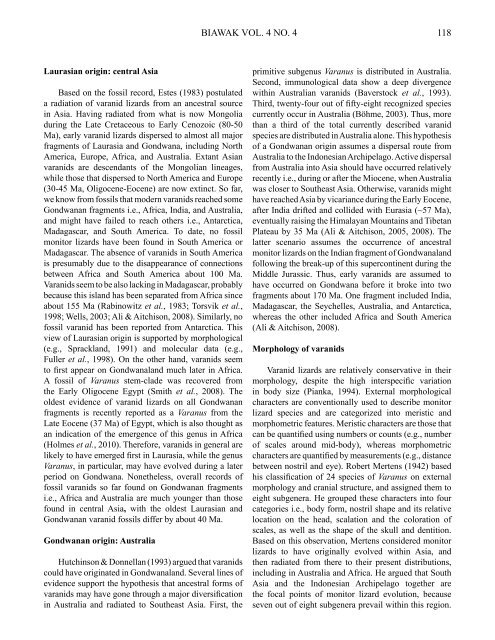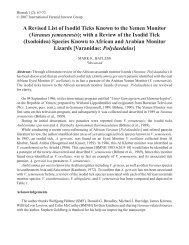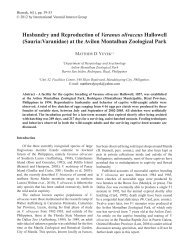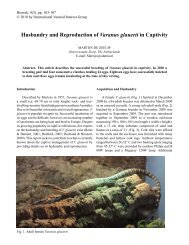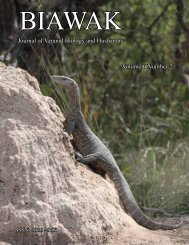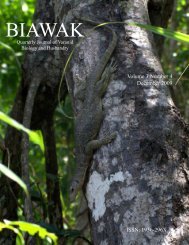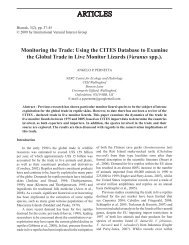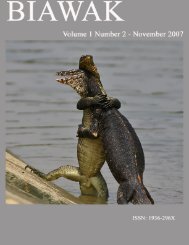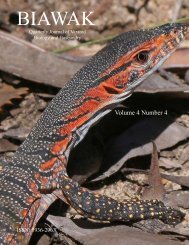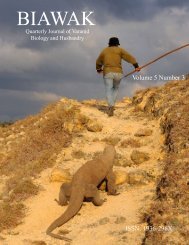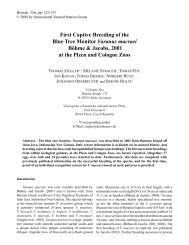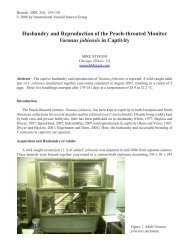BIAWAK - International Varanid Interest Group
BIAWAK - International Varanid Interest Group
BIAWAK - International Varanid Interest Group
- No tags were found...
You also want an ePaper? Increase the reach of your titles
YUMPU automatically turns print PDFs into web optimized ePapers that Google loves.
<strong>BIAWAK</strong> VOL. 4 NO. 4<br />
118<br />
Laurasian origin: central Asia<br />
Based on the fossil record, Estes (1983) postulated<br />
a radiation of varanid lizards from an ancestral source<br />
in Asia. Having radiated from what is now Mongolia<br />
during the Late Cretaceous to Early Cenozoic (80-50<br />
Ma), early varanid lizards dispersed to almost all major<br />
fragments of Laurasia and Gondwana, including North<br />
America, Europe, Africa, and Australia. Extant Asian<br />
varanids are descendants of the Mongolian lineages,<br />
while those that dispersed to North America and Europe<br />
(30-45 Ma, Oligocene-Eocene) are now extinct. So far,<br />
we know from fossils that modern varanids reached some<br />
Gondwanan fragments i.e., Africa, India, and Australia,<br />
and might have failed to reach others i.e., Antarctica,<br />
Madagascar, and South America. To date, no fossil<br />
monitor lizards have been found in South America or<br />
Madagascar. The absence of varanids in South America<br />
is presumably due to the disappearance of connections<br />
between Africa and South America about 100 Ma.<br />
<strong>Varanid</strong>s seem to be also lacking in Madagascar, probably<br />
because this island has been separated from Africa since<br />
about 155 Ma (Rabinowitz et al., 1983; Torsvik et al.,<br />
1998; Wells, 2003; Ali & Aitchison, 2008). Similarly, no<br />
fossil varanid has been reported from Antarctica. This<br />
view of Laurasian origin is supported by morphological<br />
(e.g., Sprackland, 1991) and molecular data (e.g.,<br />
Fuller et al., 1998). On the other hand, varanids seem<br />
to first appear on Gondwanaland much later in Africa.<br />
A fossil of Varanus stem-clade was recovered from<br />
the Early Oligocene Egypt (Smith et al., 2008). The<br />
oldest evidence of varanid lizards on all Gondwanan<br />
fragments is recently reported as a Varanus from the<br />
Late Eocene (37 Ma) of Egypt, which is also thought as<br />
an indication of the emergence of this genus in Africa<br />
(Holmes et al., 2010). Therefore, varanids in general are<br />
likely to have emerged first in Laurasia, while the genus<br />
Varanus, in particular, may have evolved during a later<br />
period on Gondwana. Nonetheless, overall records of<br />
fossil varanids so far found on Gondwanan fragments<br />
i.e., Africa and Australia are much younger than those<br />
found in central Asia, with the oldest Laurasian and<br />
Gondwanan varanid fossils differ by about 40 Ma.<br />
Gondwanan origin: Australia<br />
Hutchinson & Donnellan (1993) argued that varanids<br />
could have originated in Gondwanaland. Several lines of<br />
evidence support the hypothesis that ancestral forms of<br />
varanids may have gone through a major diversification<br />
in Australia and radiated to Southeast Asia. First, the<br />
primitive subgenus Varanus is distributed in Australia.<br />
Second, immunological data show a deep divergence<br />
within Australian varanids (Baverstock et al., 1993).<br />
Third, twenty-four out of fifty-eight recognized species<br />
currently occur in Australia (Böhme, 2003). Thus, more<br />
than a third of the total currently described varanid<br />
species are distributed in Australia alone. This hypothesis<br />
of a Gondwanan origin assumes a dispersal route from<br />
Australia to the Indonesian Archipelago. Active dispersal<br />
from Australia into Asia should have occurred relatively<br />
recently i.e., during or after the Miocene, when Australia<br />
was closer to Southeast Asia. Otherwise, varanids might<br />
have reached Asia by vicariance during the Early Eocene,<br />
after India drifted and collided with Eurasia (~57 Ma),<br />
eventually raising the Himalayan Mountains and Tibetan<br />
Plateau by 35 Ma (Ali & Aitchison, 2005, 2008). The<br />
latter scenario assumes the occurrence of ancestral<br />
monitor lizards on the Indian fragment of Gondwanaland<br />
following the break-up of this supercontinent during the<br />
Middle Jurassic. Thus, early varanids are assumed to<br />
have occurred on Gondwana before it broke into two<br />
fragments about 170 Ma. One fragment included India,<br />
Madagascar, the Seychelles, Australia, and Antarctica,<br />
whereas the other included Africa and South America<br />
(Ali & Aitchison, 2008).<br />
Morphology of varanids<br />
<strong>Varanid</strong> lizards are relatively conservative in their<br />
morphology, despite the high interspecific variation<br />
in body size (Pianka, 1994). External morphological<br />
characters are conventionally used to describe monitor<br />
lizard species and are categorized into meristic and<br />
morphometric features. Meristic characters are those that<br />
can be quantified using numbers or counts (e.g., number<br />
of scales around mid-body), whereas morphometric<br />
characters are quantified by measurements (e.g., distance<br />
between nostril and eye). Robert Mertens (1942) based<br />
his classification of 24 species of Varanus on external<br />
morphology and cranial structure, and assigned them to<br />
eight subgenera. He grouped these characters into four<br />
categories i.e., body form, nostril shape and its relative<br />
location on the head, scalation and the coloration of<br />
scales, as well as the shape of the skull and dentition.<br />
Based on this observation, Mertens considered monitor<br />
lizards to have originally evolved within Asia, and<br />
then radiated from there to their present distributions,<br />
including in Australia and Africa. He argued that South<br />
Asia and the Indonesian Archipelago together are<br />
the focal points of monitor lizard evolution, because<br />
seven out of eight subgenera prevail within this region.


